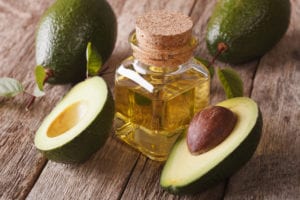Written by Joyce Smith, BS. This study demonstrates that avocatin B (AvoB), a fat molecule found only in avocados, prevented fatty acid oxidation (FAO) in skeletal muscle and the pancreas to reduce insulin resistance.
 Diet –induced obesity (DOI) is an important risk factor for metabolic syndrome, type two diabetes, insulin resistance and cardiovascular disease 1-3. There is growing evidence that DIO-induced insulin resistance can be managed by reducing FAO 4,5. The Spagnuolo research team, in 2015, discovered an avocado-derived lipid, avocatin B (AvoB), which they found to be an FAO inhibitor that accumulates in mitochondria and is toxic to leukemia cells, causing them to undergo apoptosis while remaining harmless to normal cells 6. To further investigate AvoB as a potential therapeutic for diabetics and those with obesity and metabolic syndrome, the team evaluated7 the ability of AvoB to inhibit the toxic effects of FAO in vivo, using obesity-induced mouse models and in vitro, using pancreatic and skeletal muscle cells, and finally to examine its safety for human consumption.
Diet –induced obesity (DOI) is an important risk factor for metabolic syndrome, type two diabetes, insulin resistance and cardiovascular disease 1-3. There is growing evidence that DIO-induced insulin resistance can be managed by reducing FAO 4,5. The Spagnuolo research team, in 2015, discovered an avocado-derived lipid, avocatin B (AvoB), which they found to be an FAO inhibitor that accumulates in mitochondria and is toxic to leukemia cells, causing them to undergo apoptosis while remaining harmless to normal cells 6. To further investigate AvoB as a potential therapeutic for diabetics and those with obesity and metabolic syndrome, the team evaluated7 the ability of AvoB to inhibit the toxic effects of FAO in vivo, using obesity-induced mouse models and in vitro, using pancreatic and skeletal muscle cells, and finally to examine its safety for human consumption.
Following an eight-week high fat diet (HFD), 12-week-old male C57BL/6J mice, continuing with the HFD, were given AvoB or placebo orally twice a week for a five-week duration to induce obesity and insulin resistance. They found that FAO was inhibited only in the AvoB group of mice which, when compared to the placebo group, showed improved glucose tolerance, glucose utilization, and insulin sensitivity. The AvoB-fed mice weighed significantly less (P=0.01), had significantly improved glucose tolerance (p < 0.0001), greater insulin sensitivity (P<0.01) and increased plasma levels of free fatty acids and triglycerides (P<0.001).
The preclinical mouse study was followed by an in vitro cell study designed to determine whether AvoB would be able to prevent FAO which, in turn, would increase glucose metabolism in pancreatic ß-islet (INS-1) cells. The cell study did indeed show that AvoB was able to prevent FAO in pancreatic tissue by improving glucose metabolism and stimulating insulin secretion (p < 0.0001).
Skeletal muscle utilizes approximately 70% of the body’s available glucose 8. Aware that the interplay between pancreatic insulin secretion and skeletal muscle glucose utilization is key to whole-body insulin sensitivity, Spagnuolo and team further investigated AvoB’s effect on skeletal muscle tissue. They found that AvoB was able to completely inhibit FAO in C2C12 myotubes (muscle fibers). Thus, by reducing FAO in skeletal muscle, AvoB mitigated its negative impact on insulin signaling and enhanced the ability of skeletal muscle to increase mitochondrial function and more effectively utilize glucose by increasing its uptake and oxidation.
Finally, a randomized placebo controlled pilot study of 30 participants, found that AvoB of 50 or 200 mg (equivalent to eating a quarter or one Hass avocado) per day for 60 days, was well-tolerated and safe for human consumption.
In both a mouse model and human pilot study, researchers demonstrated the effectiveness of an avocado preparation to inhibit FAO and improve glucose utilization and insulin sensitivity, therefore, making AvoB a potential agent for the treatment of obesity-related metabolic disorders.
Source: Ahmed, Nawaz, Matthew Tcheng, Alessia Roma, Michael Buraczynski, Preethi Jayanth, Kevin Rea, Tariq A. Akhtar, and Paul A. Spagnuolo. “Avocatin B Protects Against Lipotoxicity and Improves Insulin Sensitivity in Diet‐Induced Obesity.” Molecular Nutrition & Food Research 63, no. 24 (2019): 1900688.
©2019 WILEY-VCH Verlag GmbH & Co. KGaA, Weinheim
Posted December 15, 2020.
Joyce Smith, BS, is a degreed laboratory technologist. She received her bachelor of arts with a major in Chemistry and a minor in Biology from the University of Saskatchewan and her internship through the University of Saskatchewan College of Medicine and the Royal University Hospital in Saskatoon, Saskatchewan. She currently resides in Bloomingdale, IL.
References:
- Anderson EJ, Lustig ME, Boyle KE, et al. Mitochondrial H2O2 emission and cellular redox state link excess fat intake to insulin resistance in both rodents and humans. J Clin Invest. 2009;119(3):573-581.
- Després JP, Lemieux I. Abdominal obesity and metabolic syndrome. Nature. 2006;444(7121):881-887.
- Muoio DM, Neufer PD. Lipid-induced mitochondrial stress and insulin action in muscle. Cell Metab. 2012;15(5):595-605.
- Lopaschuk GD. Fatty Acid Oxidation and Its Relation with Insulin Resistance and Associated Disorders. Annals of nutrition & metabolism. 2016;68 Suppl 3:15-20.
- Zhang L, Keung W, Samokhvalov V, Wang W, Lopaschuk GD. Role of fatty acid uptake and fatty acid beta-oxidation in mediating insulin resistance in heart and skeletal muscle. Biochimica et biophysica acta. 2010;1801(1):1-22.
- Lee EA, Angka L, Rota SG, et al. Targeting Mitochondria with Avocatin B Induces Selective Leukemia Cell Death. Cancer Res. 2015;75(12):2478-2488.
- Ahmed N, Tcheng M, Roma A, et al. Avocatin B Protects Against Lipotoxicity and Improves Insulin Sensitivity in Diet-Induced Obesity. Molecular nutrition & food research. 2019;63(24):e1900688.
- DeFronzo, R. A., et al. “The effect of insulin on the disposal of intravenous glucose: results from indirect calorimetry and hepatic and femoral venous catheterization.” Diabetes 30.12 (1981): 1000-1007.
